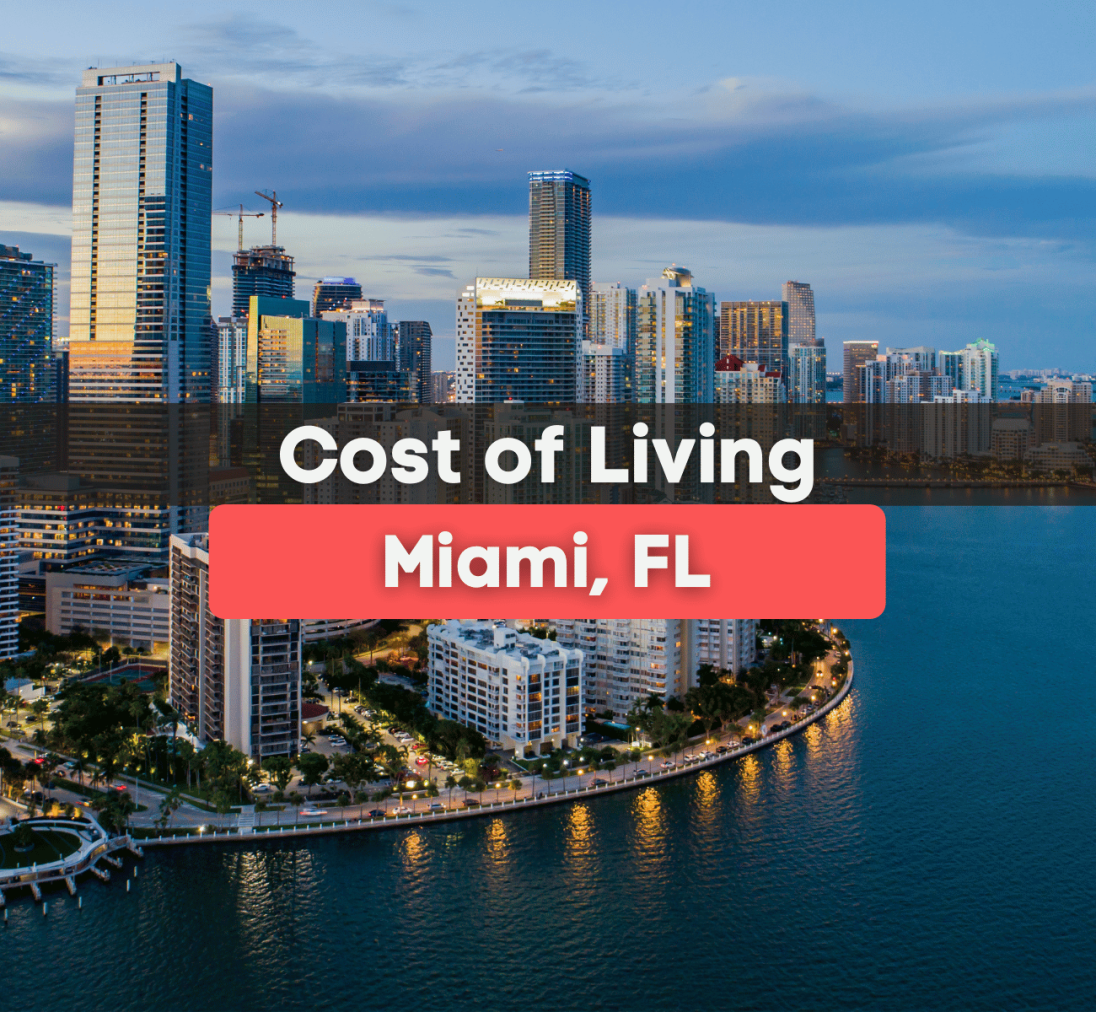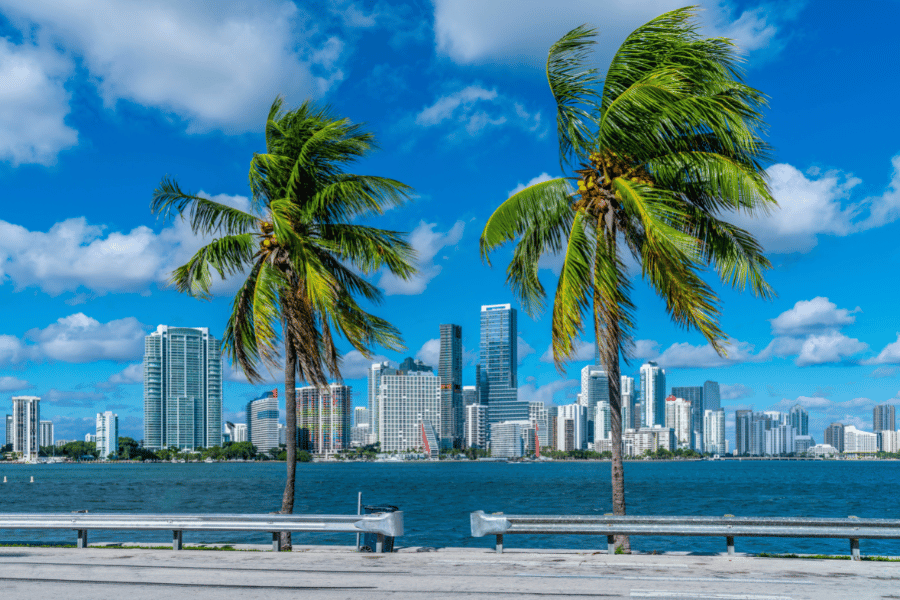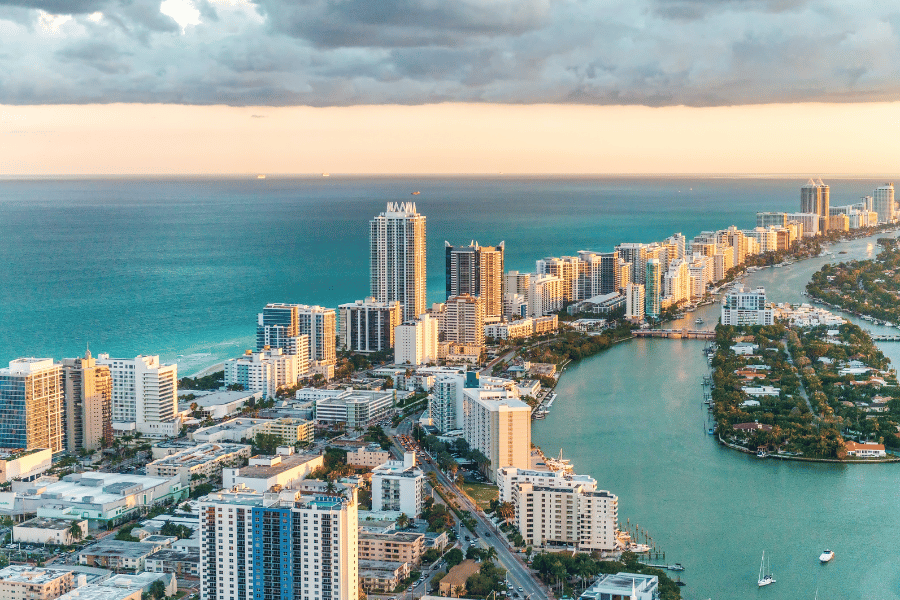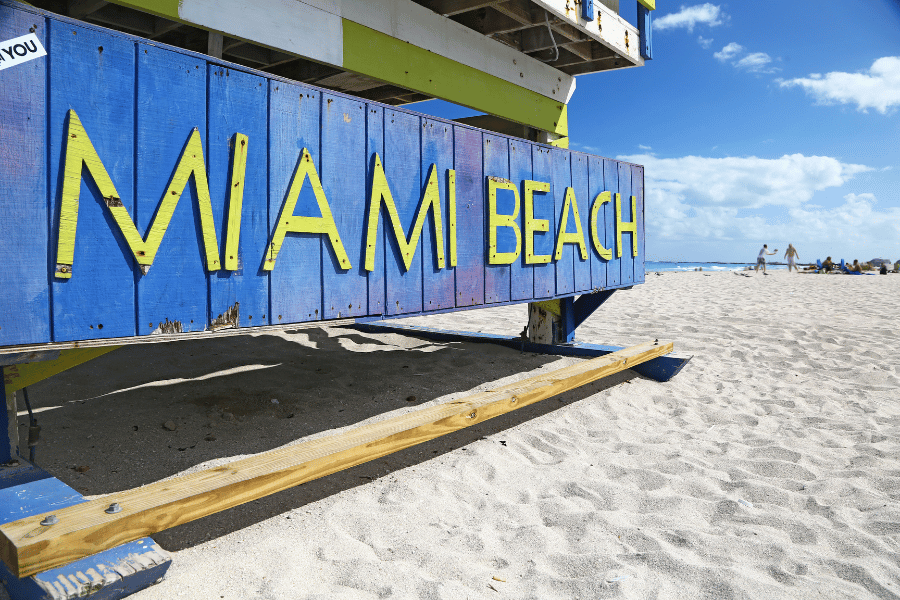April 04th, 2023

Cost of Living in Miami
Can you afford to live in Miami, FL? Follow along to learn about the cost of living, the average income, everyday expenses, and more.
The warm weather, beaches, and Cuban influence are vital factors in why Miami has experienced the largest increase in people moving in since before the pandemic. Along with fantastic weather, Miami is known as one of the most popular vacation spots, with its trendy nightlife, art galleries, world-class hotels, and delicious restaurants. That said, it can get expensive.
Miami is a major city in southeastern Florida, situated on northern Biscayne Bay between the Everglades and the Atlantic Ocean. It is the city seat of Miami-Dade County and is home to roughly 440,000 people. When walking the street of this coastal metropolis, you will be met with friendly faces, an abundance of culture, endless shopping opportunities, and more.

Miami's history is "colorful, magnetic, and exotic." What started off nicknamed the Magic City has evolved into a major international port and a gateway for global industries. They call it the Magic City because it miraculously sprung up overnight.
If you're considering moving to Miami and are trying to figure out your financials, you're in the right place. When moving somewhere new, you'll first want to determine if you can afford the cost of living. Diving into the cost of living can be overwhelming. You must look at the real estate market, the population, healthcare, food/groceries, taxes, etc. Lucky for you, we have put together this guide to make it easier for you! Continue reading to have all of your cost of living questions answered.
Cost of Living
The cost of living varies in every state, city, county, etc., and is strongly influenced by your income, career, and everyday expenses. As the city seat, the Greater Miami area is the state's largest urban concentration and comprises all of the county. The county includes Miami Beach, Coal Gables, Hialeah, North Miami, and other smaller municipalities and unincorporated areas.
According to Payscale, the cost of living in Miami, FL, is 21% higher than the national average. However, the median annual income is $3,343 higher than the national average. Being a populated area, Miami's housing expenses are 47% higher, and utility prices are 1% higher. It is said that monthly costs for a family of four are $4,366. With the median household income being $47,860, the monthly costs of living in a big city are reasonable depending on your lifestyle and spending habits.
According to RentCafe, the average apartment is $2,356, and the average square footage is 888. Your monthly costs depend on your apartment size, unit type, location, etc.
If you're moving from other high-cost cities like New York or San Fransico, Miami is affordable and has a lower cost of living. If you're local or coming from a small town, you may want to budget and plan for increased costs before deciding to move.
| Cost of Living Item | Miami | National Average |
| Annual income | $34,295 | $37,638 |
| Rent | $1,361* | $538* |
| Mortgage | $2,230* | $1,697* |
| Home Value | $369,100* | $244,900* |
| Natural gas | $2.86 | $1.67 |
| Electricity (kWh) | $0.14 | |
| Public transportation | $111 (monthly pass) | $102 per month |
| Gas | $3.39 | $3.45 |
*Denotes median rather than average
Data gathered from the U.S. Census Bureau, AAA
Income
The average median income for someone living in Miami is $34,295, which is slightly lower than the national average of $37,638. When planning a move and looking at your income, it's essential to consider your lifestyle. Could you afford to live off of the median income? Would it be more beneficial to split the cost with a roommate? The median household income in Miami is $47,860, $13,565 higher than the per capita income.
While the cost of living may be high, Miami has countless job opportunities and a robust economy. Miami is home to the nation's largest hospital and the world's largest tourist seaport. With the constant warm weather and bustling climate, Miami is a great place to live and work. The top employment industries are:
- Healthcare: 4.6%
- Transportation: 7.2%
- Sales: 20.5%
- Office and administration: 13.4%
- Construction: 9.9%
- Cleaning and maintenance: 11.5%
- Food service: 13.1%
- Management occupations: 19.8%

According to the U.S. Bureau of Labor Statistics, the current unemployment rate in Miami-Dade County is 2%. This is lower than the national average of 3.6% and could be credited to the abundance of jobs and large manufacturers in the area. Although there are plenty of jobs and opportunities, the recent census bureau stated that the poverty rate in Miami is 20.9%. This means that 20.9% of the Miami population lives below the poverty line, even if they are employed.
Real estate
With Miami's recent population growth, the housing market has seen massive inflation. When browsing, you may find your dream home, but consider the area you choose to live in compared to your income. As of the latest Census, the rate of owner-occupied housing and renting were roughly the same. According to the U.S. News, the median home value in December 2022 was $455,000. Although, builder permits and new construction homes are trickling downward.
Rent and sales prices have been increasing lately due to the growing population. Homes are selling for the asking price and even slightly above. Miami is the seventh-most populous metro area in the U.S. and continues to attract new residents daily. Regarding home affordability, the average 30-year, fixed-mortgage interest rate was 6.36% as of December 2022.
February 2023 statistics:
- Median sold price: $503, 304
- 3-bedroom median sold price: $514.7K
- 5,5779 homes for sale in February 2023
- 619 homes sold in February 2023
- Average of 57 days on the market
Utilities
The cost of utilities is often an expense that's overlooked or forgotten when moving. Utilities can vary significantly or slightly based on your state, so it's essential to do your due diligence before choosing an area to move to. The cost of utilities is relatively low but still 1% higher than the national average. You can expect to spend roughly $100 - $200 a month. This price includes electricity, heating, and water. However, according to Payscale, the average energy bill is $172.32 per month, and the average phone bill is $191.62.
Garbage collection is a service not included in your utility bill but is necessary. If you own residential property in Miami, you must cover the $484 garbage collection fee. Garage fees may be added to your base rent or appear as an additional fee if you are a renter.
When budgeting for utilities, you should also factor in Wifi. EarthLink is Miami's most affordable internet provider, starting at $49.95 per month. The fastest internet provider is AT&T which starts at $55 per month. When factoring in the cost of utilities, it's always a good idea to overestimate.
Food
Food is a necessity in everyone's life. It's part of your budget that cannot be overlooked or forgotten. The cost of dining out, groceries, etc., varies in every state and is typically higher in more extensive and populous areas like Miami.
According to the United States Department of Agriculture, households in the lowest income quintile spent an average of $4,875 on food annually in 2021. Food costs depend on inflation, and as you know, the U.S. has seen a rise.
In Miami, the price of groceries is 7.3% higher than the national average. Residents should expect to spend roughly $375 monthly on food, $33 per day, and $13 per person. Take a look at the average costs for basics:
- Loaf of bread: $4.66
- A gallon of Milk: $2.92
- Carton of eggs: $2.70
- Bunch of Bananas: $4.03
- Hamburger: $6.16

Taxes
Taxes are another moving expenses that are forgotten about. And again, taxes vary based on the state/county you live in. The minimum combined 2023 sales tax rate for Miami is 7%. However, the Florida sales tax rate is currently 6%. The county sales tax rate is 1%, and the Miami sales tax rate is 0%.
Transportation
Miami has plenty of options if you do not own a vehicle and rely on public transportation to get you from point A to B. The Metrobus serves all major shopping, entertainment, and cultural centers, as well as hospitals and schools. The bus can take you to Miami Beach, Key Biscayne, West Miami-Dade, Broward County, Homestead, Florida City, and the Middle Keys. A 1-month pass for the Metrobus costs $112.5. Other public transportation options in Miami-Dade County include:
- Metrorail: $112.5 per month
- Metromover: free
If possible, the best and easiest way to get around Miami is via car. A majority of the top attractions are spread out and would require you to take multiple different buses. The buses also do not take you to every part of Miami or the county in general. If needed, you can rent a car at the Miami International Airport.
If you plan to stay strictly in Miami, a car is not necessary; you can get around on foot. There are also bike rentals that you can get individually or through a bike-sharing system.
Education
If you're moving to Miami with your children or to attend a university, then Education should also be something you consider before making a move. The Miami-Dade public school system is the 4th largest school district in the U.S. With 333,500 students, it has been an A-rated school district for three consecutive years.
The University of Miami is another reason the area sees an influx of people, especially those in their late teens to their early 20s. Here is a breakdown of the costs you can expect if you attend the Univerisity of Miami:
| Expenses | Undergraduate on Campus | Undergraduate off-campus or University Village | With Parent/Relative |
| Tuition (2) | $58,102 | $58,102 | $58,102 |
| Fees | $1,838 | $1,838 | $1,838 |
| Food and Housing (1) | $22,064 | $22,930 | $9,282 |
| Books | $1,328 | $1,328 | $1,328 |
| Personal | $3,630 | $3630 | $3,630 |
| Transportation (3) | $1,926 | $1,926 | $1,926 |
| Loan fees | $50 | $50 | $50 |
| The total cost of attendance | $88,938 | $89,804 | $76,156 |
You can also attend Miami Dade College or Miami University.
FAQ
How much do you need to live comfortably in Miami?
The cost of living in Miami is significantly higher than in smaller cities. You would need to make roughly $3,080 per month to get by.
What is the minimum wage in Miami?
Florida's state minimum wage rate is $11 per hour.
Is Miami a good place to live?
Miami is a beautiful place to live for those who enjoy beaches, warm weather, culture, etc. However, they have a relatively high crime rate.
Is housing expensive in Miami?
Miami's housing expenses are 47% higher than the national average.
The Cost of Living in Miami, FL - Final Thoughts
Miami, FL, can be an expensive place to live if you are not budgeting correctly. Before moving to the Sunshine State and tourist hot spot, consider the housing costs, transportation, taxes, Education, and the overall cost of living. Living comfortably and within your means is essential, so researching Miami and creating a budget plan is important.
Although it's cost, Miami is a great place to live. Your day-to-day life in Miami is surrounded by culture and new experiences. U.S. News claims Miami is one of the most vibrant metro areas in the U.S. So, after looking into the cost of living, can you afford to live in Miami?
If the answer is yes, feel free to contact us! We have a team of experienced agents who would happily help find you your dream home.

Ryan Fitzgerald
Hi there! My name is Ryan Fitzgerald, and I am a REALTOR®. My goal is to help you learn more about real estate through our Real Estate Blog! Hopefully, you enjoyed the above blog post and it found a way to provide help or value to you. When you're ready to buy or sell a home of your own let us know here. Please feel free to join the conversation by dropping us a comment below.


